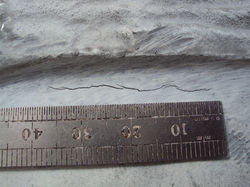Conventional NDT
Non-Destructive Testing (NDT) is the branch of engineering concerned with all methods of detecting and evaluating flaws in materials. Flaws can affect the serviceability of the material or structure, so NDT is important in guaranteeing safe operation as well as in quality control and assessing plant life. The flaws may be cracks or inclusions in welds and castings, or variations in structural properties that can lead to loss of strength or failure in service. The essential feature of NDT is that the test process itself produces no deleterious effects on the material or structure under test.
Conventional NDT services
-
Magnetic Particle Inspection
-
Dye Penetrant Inspection
-
Ultrasonic Testing
-
Eddy Current Inspection
-
Radiography
-
Visual Inspection
Magnetic Particle Inspection (MPI)
Magnetic Particle Inspection (MPI) is used for detecting surface and near surface discontinuities in ferromagnetic materials.
When a magnetic field is induced into the material by using an electromagnet, the presence of a surface breaking defect will create a leakage field.
This leakage field is made visible to the human eye by use of finely divided ferromagnetic particles which are attracted to the leakage field thus giving a visible indication of discontinues, their size, location and shape.
Dye Penetrant Inspection (DPI) / Penetrant Testing (PT)
Penetrant testing is used for detecting surface breaking discontinuities in Ferromagnetic and non-Ferromagnetic materials.
Penetrants are brightly coloured dyes that are applied to the surface of the test material and given time (Dwell time) to enter into any defects. Penetrant testing can be used on any non-porous material.
On completion of the Dwell period a highly absorbent developer is lightly sprayed onto the test area, drawing out dye from any discontinuity. The developer offers a contrast to the colour of the dye making interpretation of any defects highly visible. Alternative Penetrant methods include Fluorescent PT for use on carefully machined surfaces.
Ultrasonic Inspection (UT)
Ultrasonic Testing is the technique that measures the time for high frequency pulses of sound waves to travel through the inspection material, the frequencies are usually 0.1 – 15MHz but occasionally up to 50MHz. If a discontinuity is present, the sound wave will return to the probe in a shorter time than expected from a fault free specimen.
Eddy Current Inspection (ECI)
Eddy current testing is the technique where electrical currents are induced in to the material being inspected and observing the interaction between the currents and the material. Eddy currents are generated by coils in the probe and is monitored simultaneously by measuring the change in impedance in the coils. As eddy current is an electromagnetic induction process, direct contact with the material is not required, however, the material must be an electrical conductor.
Radiographic Tetsing (RT)
A well established NDT technique, radiography uses gamma-rays or X-rays to produce the image of an object onto film. The source of radiation is either an X-ray tube, which is normally described by the electrical voltage across the X-ray tube with the higher the voltage the higher the penetrating power of the radiation or a sealed source of radioactive material emitting gamma-rays: Iridium 192, Cobalt 60, Selenium 75, Ytterbium 169. Applications include wall loss detection and sizing in pipes and plate through to manufacturing defects in welds, forgings castings etc.
Visual Inspection (VT)
Comprehensive job specific courses are offered in-house to meet our client’s contractual requirements, including Coatings & Insulation Inspection.
 |
|---|
 |
 |
 |
 |
 |
 |
